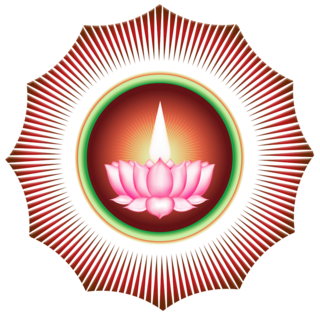
Ayyavazhi is a henotheistic belief that originated in South India. It is cited as an independent monistic religion by several newspapers, government reports, journals, and academic researchers. In Indian censuses, however, the majority of its followers declare themselves as Hindus. Thus, Ayyavazhi is also considered a Hindu denomination. Officially (legally), it exists within Hinduism as a Hindu denomination.

Nizhal Thangal also called Inai Thangals) are secondary worship places of the Ayyavazhi, often smaller in size compared to Pathis, built per the instructions of Akilattirattu Ammanai. Cleanliness is strictly enforced.

Pathi is the name of the primary centres of congregational worship for the South Indian religious system of Ayyavazhi, having a relatively large structure like that of a temple. They are seven in number.

Ambala Pathi, also called as Pallathu pathi or Moolakunda pathi is one of the primary pathi of the Ayyavazhi, and the second important pilgrim centers of Ayyavazhi, and the place where Ayya Vaikundar is said to have unified all divine power into himself by symbolic marriages.

Mutta Pathi, is one of the Pancha pathi, which are the primary centers for worship of the Ayyavazhi. This is the third important pilgrim center of Ayyavazhi. This place earn the religious importance in Akilam from the event that, Ayya Vaikundar is given two Vinchais here by Narayana under the Sea; One just before the arrest of Vaikundar by Swathi Thirunal and the second after the completion of Thuvayal Thavasu.

Thamaraikulam Pathi, is one among the Pancha pathi, the five holy places of Ayyavazhi. The Ari Gopalan Citar, who wrote the Akilam was born here.

Pancha pathi are the five important pilgrim centers of Ayyavazhi. These are also considered as the primary Pathis and as worship centers of Ayyavazhi with primary status. The first pathi is Swamithope pathi itself and is the headquarters of Ayyavazhi. The other Pathis are Muttappathi, Thamaraikulam Pathi, Ambalappathi and Pooppathi.

The Arul Nool is a supplement to the Akilattirattu Ammanai, and is likewise considered a holy scripture of Ayyavazhi. This book contains the collection of messages given by Ayya Vaikundar to his Disciples, whose names are unknown. Since they are believed to be composed by Arylalarkar, it acquired the name Arulnool. There is no direct indication within the book regarding the time of its composition.

The following outline is provided as an overview and topic guide to Ayyavazhi:

Ayyavazhi and Hinduism are two belief systems in India. Although Ayyavazhi continues to officially exist within Hinduism and is considered by some observers to be a Hindu denomination,some members of the religion claim that it is independent. The most notable distinction between Hinduism and Ayyavazhi is their different approaches to the concepts of good, evil and dharma.

Thirunamam(Tamil: திருநாமம்; Tirunāmam)) represents the 'Sacred name of God'. The phrase Namam also represents the white clay found at the deeper layer of earth, which is used as the powder to wear a flame shaped mark. The Ayyavazhi people wore this Namam, starting from the central point between the eyebrows, going straight up near the top edge of the forehead.

The History of Ayyavazhi traces the religious history of Ayyavazhi, a belief-system originated in the mid-19th century in Southern India. Ayyavazhi came to be noticed by the large number of people gathering to worship Ayya Vaikundar in the middle of the 19th century. The majority of the followers of Ayyavazhi were from marginalised and poor sections of society.

The purpose of this chronology is to give a detailed account of Ayyavazhi from the beginning of the incarnational events of Vaikundar to the present time. Question marks on dates indicate approximate dates. A star (*) indicates the mentioning of that particular date in Akilam or Arul Nool. All dates but a few are found in the Tamil calendar and so doesn't coincide exactly with the months of the Gregorian calendar. The dates may span over any halves of the two consecutive months (Gregorian).
This Nizhal Thangal is situated 3 km west to Swamithope. There was a zeouse devotee for Vaikundar during his period. During the last phase of the Tavam, Vaikundar avoid speaking to anybody. So for giving message for the people Vaikundar blessed Mr. Swamiyadiyan of Eachan vilai, one of his devotee that, what ever Ayya think in his mind it will be heard by this man. Since he was booned to realize the thoughts of Vaikundar, he was called as "Varam petra Pandaram" - 'The booned mendicant'.
This Thangal of Vadalivilai was the fifth among the Primary Nizhal Thangals. After the Kodiyettru Thirunal of Swamithope in 1850, the devotees of Ayya from Vadali vilai of Tirunelveli district requested Ayya to visit their village, during their holy visit to Swamithope. Accepting their request Ayya visited that village and laid stone for the Thangal there. Then a palmyra-leaf made structure was erected there and Panividais are conducted regularly.
This Thangal of Kadambankulam was the sixth among the Primary Nizhal Thangals. This Thangal was situated South to Valliyoor, 2 km southeast to Kalantha panai. This was the place where Thavam petral, the daughter of Dharma Citar was married to a man from here. Also, this was the native place of Thuvayal Pandaram, who were the participants of the Thuvayal Thavasu. Ayya also visited this place before his Six-year Tavam. Likewise this place gains so many importance from Ayyavazhi.
This Thangal of Pambankulam was the seventh among the Primary Nizhal Thangals. Then immediately after participating in the celebrations in Kadambankulam, Ayya reached Pambankulam. This Thangal was situated west to Kadambankulam in the Tirunelveli-Kanyakumari National Highway east to Panakkudy.

Ayyavazhi phenomenology is the phenomenological variations found in Ayyavazhi society, worship centers etc. from their holy text Akilattirattu Ammanai.

The festivals and celebrations play an important role in the socio-religious universe of Ayyavazhi. Some of the festivals are common for both Pathis and Nizhal Thangals, while some are confined to Pathis. In Swamithope pathi, every day is celebrated as a festival with the name 'Nitham Thirunal'. Normally all the festivals are celebrated grandly in Swamithope than any other worship centers of Ayyavazhi. LMS reports to witness such festivals.

Swamithoppe Pathi is the primary pathi of the Ayyavazhi, and the sacred venue of the Tavam. Religiously Swamithope is considered primary among the Pancha pathi and the primary centre of the incarnational activities of Vaikundar.





